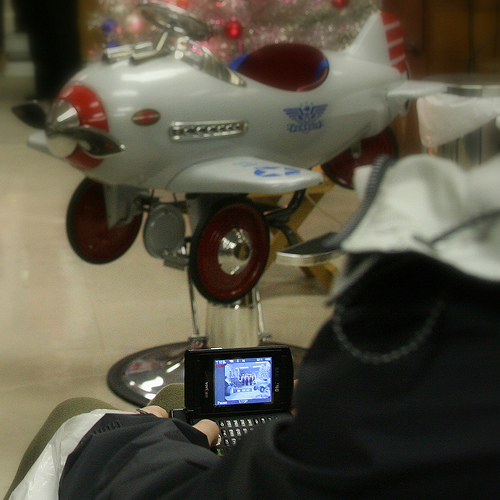Local Content Considered Key to Mobile DTV Adoption
WASHINGTON and NEW YORK: Nine out of 10 cell-phone users would watch local news on their handhelds or a comparable mobile device. The continual push behind mobile video will drive a 34 percent increase in ad spending across mobile devices next year. Those are the conclusions of a survey of cell phone users and an industry forecast on mobile ad spending. Both are encouraging to an industry under pressure to give up radio frequency real estate and make up for lost revenues.
The user survey finding substantial interest in local mobile content was commissioned by the Open Mobile Video Coalition of TV broadcasters. The group has a vested interest in the public appetite for local content on cell phones, given broadcasting’s entry into mobile video rests on that particular. OMVC commissioned Magid Media Labs to survey 1,000 adults.
Magid found that 88 percent of those responding to the survey “expressed interest” in watching local news on cell phones, laptops, smartphones and netbooks. Around 50 percent said they’d look into buying an ATSC M/H-capable device--those that receive over-the-air, mobile DTV signals. People 18-to-29 registered twice the interest in watching local content on mobile devices compared to their current consumption on conventional TVs.
“There is no current service that delivers robust over-the-air local broadcast TV news and information to a portable device, but we anticipate dozens of new products to be available along with new mobile DTV signals that have already begun to roll out around the country,” said Brandon Burgess, head of the OMVC.
ATSC M/H, the mobile DTV standard, became official in October. Compatible devices are expected to debut at the Consumer Electronics Show in Las Vegas in January. Several service trials have been held in markets around the country, but there have been no commercial deployments.
There are around 237 million cell-phone users in the United States. Currently, around 15.7 million of them watch video on the devices, according to Nielsen. Service providers--AT&T, Verizon, Sprint--already provide video offerings on cell phones, though none offer the type of local news for which broadcast TV stations are known. A coalition of broadcasters has formed the “Pearl Project” to persuade cell service providers to incorporate ATSC M/H reception into their phones, published reports indicate.
Mobile DTV is the broadcast industry’s latest prospect for new revenues, though some in the industry are skeptical about its potential. There’s a bitrate trade-off to transmit mobile DTV signals, e.g., it requires more bandwidth than what is actually delivered to devices. That’s bandwidth taken away from the primary signals, which remains the major money-maker. However, the numbers coming down the pike for mobile ad spending are growing, presenting broadcasters with the opportunity to make up for revenues lost in the collapse of the automotive industry.
Borrell Associates estimates that mobile ad spending across the 210 TV markets will increase by 34 percent between this year and next. This year’s estimate is $2.59 billion; next year, mobile device ad spending is projected at $3.48 billion. Borrell’s estimate exceeds one proffered by BIA last March, predicting a mobile ad take of $3.1 billion by 2013.
Either way, segment growth is expected. Borrell’s forecast includes a market-by-market breakdown that suggests a geographic divergence in adoption of mobile media.
Abilene-Sweetwater, Texas, market No. 165, is expected to see a 113 percent growth in mobile media revenues, according to Borrell--from $2.57 million this year to $5.48 million next year. By comparison, Austin, Texas, No. 49, is expected to stay flat at around $13.8 million.
Glendive, Mont., the nation’s smallest designated market area at No. 210, is projected to log the largest percentage growth mobile revenues at 430 percent to $1.25 million.
Growth is projected for all top 10 markets, with Washington, D.C., No. 9, leaping most with a 118 percent increase to nearly $210 million in mobile revenues next year. No. 1 New York is tagged as the top grossing market next year, with a projected $267.8 million in mobile revenues.
The full Borrell report is available at TVB.org.
(Image by Mark Preuschl)
More on mobile TV:
October 16, 2009: “Mobile DTV Standard Adopted”
October 7, 2009:“Wireless Carriers Build Mobile TV as Broadcasters Prepare for Launch”
October 7, 2009: “Qualcomm Rolls out Handheld FLO TV”
September 3, 2009: “Gray Conducts Successful Mobile DTV Tests”
August 26, 2009: “Free Analog Mobile TV Bode Well for Digital Version”
June 29, 2009: “More on Mobile from Overseas”
April 20, 2009: “NAB: Broadcasters Target D.C. for Mobile TV Consumer Trials”
April 20, 2009:“City of Raleigh Initiates First Public Mobile DTV Deployment”
March 20, 2009: “Mobile DTV Poised for Rising Revenue Wave”
February 17, 2009: “MobiTV Tops 6 Million Subscribers”
January 12, 2009: “Mobile DTV to Launch in 22 Markets Immediately”

Get the TV Tech Newsletter
The professional video industry's #1 source for news, trends and product and tech information. Sign up below.
